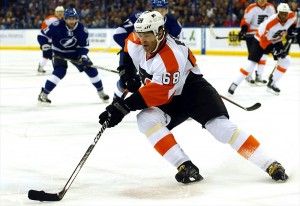Until Saturday, the Philadelphia Flyers’ offensive woes had bordered on historical levels of futility. The team’s inability to score three goals in a game was as comical as it was infuriating to a fan base that has become increasingly more cynical (if that’s even believable).
Prior to the Flyers’ Thursday night 2-1 victory over an equally struggling New York Rangers’ squad, head coach Craig Berube announced some major line shakeups. Vinny Lecavalier returned for the contest after missing the prior three with a lower-body injury, and before taking his first shift in return, he was promoted to the top line, playing on Claude Giroux’s right wing.
Lecavalier, a lifelong center by trade, seemed to react to the switch well. While he was not a factor on the score sheet, it was clear he brought a shooting threat that Giroux has lacked since being flanked by Jaromir Jagr and a much better (and healthier) Scott Hartnell in 2011-2012.
Hartnell, like Lecavalier, had been on the shelf battling injury before returning to the Flyers for their matchup on Saturday at the Nassau Coliseum. He has been removed from Giroux’s line in the meantime in favor of rookie Michael Raffl.
Lecavalier the Difference in Flyers’ Turning of Corner?
Despite yet another subpar offensive performance on Thursday, the Flyers did ride goalie Steve Mason to a 2-1 victory, and Berube kept the top line in tact, along with a revamped second line including Hartnell, Brayden Schenn and Jake Voracek.
Couple these changes with the promotion of Mark Streit to the top power play unit, replacing Kimmo Timonen, and the results, even if for one night, showed some resolve in what had been a stagnant Flyers offense.
On an early power play, the Flyers kept things simple, with Streit feeding Lecavalier for one of his textbook one-timers from the top of the circles that escaped New York goaltender Kevin Poulin.
Less than a minute later, armed with an early goal, the second line fed off the energy, as Voracek roared down the wing, cut to the middle, put a shot on goal and found twine for the first time in his tenth game. Lecavalier would add another goal on a deft deflection in tight out of mid-air.
In less than 20 minutes, the Flyers had eclipsed their highest goal output of the season, and Lecavalier scored as many goals as any of his teammates had all season, with two.
The Islanders, not surprisingly, pushed back, but armed with goal support for the first time all season, Mason calmly backstopped Philadelphia to a 5-2 win over an Islander team that had just beaten the Penguins a night earlier.
Is the Wing Better for Lecavalier than Center?
It is interesting to note just how much more of a bona fide sniper than playmaker Lecavalier has been throughout his hockey career. The center position is normally more known for the game’s best puck handlers and passers (see Sidney Crosby, Joe Thornton, and the Giroux of 2012 for proof of that).
Soon after being drafted first overall by the Lightning in 1998, the Quebec native displayed his nose for the net, scoring 20 goals or more each year between 1999 and 2004, including nine in the Lightning’s run to the Stanley Cup in 2004 (four against the Flyers).
While he has posted over 50 assists twice in his career, that total is low when compared to centers of similar talent and skillsets. After the NHL lockout, Lecavalier came out firing first and passing second, scoring 35, 52, and 40 goals respectively in the first three seasons of the “new NHL.”
As his ice time began to decrease and his abilities suffered under Rick Tocchet’s and Guy Boucher’s systems, Lecavalier’s numbers fell, and some saw this as him becoming disinterested.
However, on a Philadelphia team that is not shy about wanting to flex its offensive muscle, Lecavalier has been given a chance to rekindle his old goal-scoring prowess.
There’s no secret Giroux has badly missed the presence of Jagr. While the Czech legend “only” scored 19 goals for the Flyers at age 39-into-40, his presence allowed Giroux and Hartnell to play with, to date, their highest levels of confidence; both players recorded career high point totals with Jagr as their right-winger.
Similar to Jagr, Lecavalier is a big body (6-foot-4) that is very tough to force off the puck, with a lethal shot when he uses it. The stark contrast between the two is Lecavalier’s potent one-timing abilities, an element that Jagr has admitted to being a weaker part of his otherwise legendary game. Also, at age 33, while he is no spring chicken anymore, Lecavalier certainly has the ability to provide productive seasons given the right situations, system and linemates.

Was the Lecavalier Hat Trick Just a Mirage?
Certainly, any Flyer fan (and rightfully so) may be skeptical of Saturday’s breakout game being a sign of big things to come. After all, the Flyers were playing an Islander team that had played a tough, nail-biting game in Pittsburgh the night before. They also dressed their backup goalie, Poulin.
However, Giroux’s two assist night, Lecavalier’s hat trick, and Voracek breaking into the goal column are three giant pieces of good news for a team that needed any good breaks it could find.
Assuming Mason can continue his remarkable play in goal (again, perfectly acceptable to be skeptical of this notion), the Flyers can at least take solace in the fact that they are not being blown out of the water.
With Lecavalier’s age only rising in this, the 15th anniversary of his NHL debut, perhaps a winger-sniper mentality (with fewer defensive responsibilities) can rejuvenate him and the Flyers’ offense on the whole.
Lecavalier might be no Jaromir Jagr, but for now, he is as close as the Flyers are going to get, even if he is learning the right side for the first time in his NHL life.